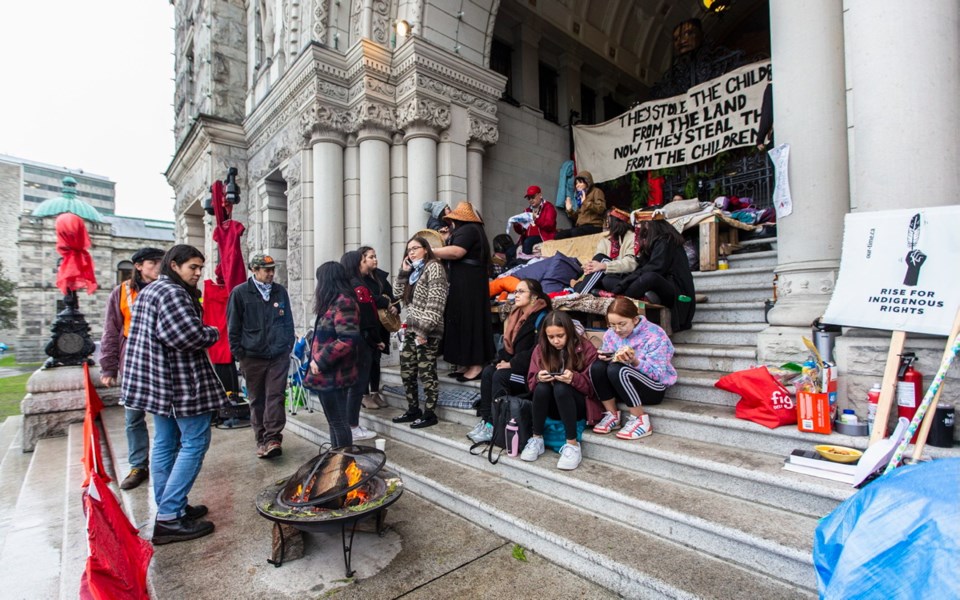Supporters of Wet’suwet’en hereditary chiefs camped at the legislature are responding to vague online threats by holding talks on how to de-escalate confrontation.
In small groups, supporters were told to make their safety a priority and remain peaceful and non-confrontational regardless of how they’re approached, said Gordy Bear.
Bear, who is Cree and Métis, has studied non-violent crisis prevention and intervention. “We meet people where they’re at, but we make sure that it never escalates to a place of violence,” he said.
Informal workshops took place Saturday, after rumours swirled online that members of a white supremacist group were planning to target people involved in blockades and other actions that support Wet’suwet’en hereditary chiefs. The chiefs represent five clans who oppose construction of a natural gas pipeline through their territory in northern B.C.
Victoria police are aware of the concerns raised by the group at the legislature, and are there to keep everyone safe, said spokesman Bowen Osoko.
“We have not heard or seen indication from other groups that something is planned,” he said.
A Facebook group called “Remove the Illegal Blockades February 29th 12 noon!” has more than 400 members discussing blockades around the country that brought train service to a halt.
Some posts on the Facebook page encourage violence against protesters. One post shows a video of a model train running down a figurine of a person on the tracks with the caption: “Here’s how you take care of them!” Another suggests sending blankets infected with coronavirus to protesters, a reference to smallpox-contaminated blankets that settlers were said to have given to Indigenous people to wipe out their populations.
The messages are indicative of the anti-Indigenous racism that has surfaced since rail, port and road blockades popped up around the country in early February when RCMP moved in on a critical roadway in the pipeline project and started making arrests. “This whole event has ripped this mask off of Canada and exposed the racism, the hate and the violence that goes on here,” Bear said.
That hate has the group on alert, making sure to introduce themselves to newcomers and suss them out after they were visited by pipeline supporters and others who want to disrupt their occupation of the legislature, Bear said.
They’re ready with a first-aid tent and trained responders are on standby in case of any injuries, but so far the tent has only seen people who tripped on the legislature stairs, or slipped in mud and suffered sprained ankles, he said.
“Nothing has been violent. That’s what’s so cool. That gives me so much pride being here,” Bear said. “At the same time, it’s really sad we have to have all this protocol just to feel safe.”
Anti-police rhetoric has also found a home on social media, with many making claims that white supremacists visited the legislature Friday night after police left, calling the timing “convenient.”
The group at the legislature said that several suspicious people hung around their tents Friday night, and one person drove around the block four times while honking aggressively and flipping them off, but no one was definitively linked to any group.
Officers with Legislative Assembly Protective Services have been at the building 24 hours a day, and there are Victoria police officers on special duty every day at the legislature, Osoko said. The police officers respond to other calls, so their presence depends on what else is going on, he said.
All Victoria police officers and staff undergo regular bias testing to understand how they subconsciously react to different groups of people and address that bias. “It comes from the concept that everyone has implicit biases. It’s about being able to identify and mitigate the impacts of implicit bias,” Osoko said.
The group of young, Indigenous people occupying the legislature steps has shared livestreams of their rallies to their Facebook page, Indigenous Youth for Wet’suwet’en. Some of the videos have been watched by people around the world. “Prayers and support from Australia and New Zealand’s Indigenous,” wrote one commenter.
Wet’suwet’en hereditary chiefs entered a third day of talks Saturday with Federal Crown-Indigenous Relations Minister Carolyn Bennett and B.C. Indigenous Relations Minister Scott Fraser.
While five elected Wet’suwet’en chiefs have signed benefit agreements with Coastal GasLink, hereditary chiefs representing five clans oppose the project and say they retain title to the land outside of the federal reserve.
Bear said the benefit agreements between elected band councils and Coastal GasLink will only benefit people living on reserve.
“It’s not doing anything for the rest of the nation that is out there making sure they still have land for their kids to grow up in,” he said. “So that is excluding a huge majority of people.”



